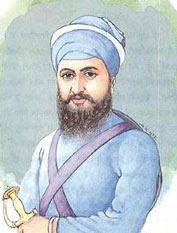Bhai Daya Singh Ji

In 1677, he travelled to Anandpur Sahib Ji along with his family including his young son, Daya Ram, to make obeisance to Guru Gobind Singh Ji, this time to settle there permanently. Daya Ram, already well versed in Punjabi and Persian, engaged himself in the study of classics and gurbam. He also received training in the use of weapons. In the historic divan in the Kesgarh Sahib Ji Fort at Anandpur Sahib Ji on 30th March 1699, he was the first to rise at the Guru's call and offer his head, followed by four others in succession.
These five were the first to be admitted to the fold of the Khalsa and they in turn administered the rites of initiation to Guru Gobind Singh Ji who called them collectively Panj Pyare. Daya Ram after initiation became Daya Singh Ji. Although the five enjoyed equal status as the Guru's close confidants and constant attendants, Bhai Daya Singh Ji was always regarded as the first among equals. He took part in the battles of Anandpur Sahib Ji, and was one of the three Sikhs who followed Guru Gobind Singh Ji out of Chamkaur on the night of 7th December 1705, eluding the besieging hordes. He was Guru Gobind Singh Ji's emissary sent from the village of Dina in Punjab to deliver his letter which became famous as Zafarnamah, the Letter of Victory, to Emperor Aurangzeb, then camping at Ahmadnagar.
Bhai Daya Singh Ji, accompanied by Bhai Dharam Singh Ji, another of the Panj Pyare and reached Ahmad nagar via Aurangabad. He found that it was not possible to have access to the Emperor and deliver to him the letter personally as Guru Gobind Singh Ji had directed. Bhai Daya Singh Ji sent Bhai Dharam Singh Ji back to seek Guru Ji's advice but before the latter could rejoin him with fresh instructions, he had managed to have the letter delivered, and had himself returned to Aurangabad.
Bhai Daya Singh Ji and Bhai Dharam Singh Ji returned and, according to Sikh tradition, they re-joined Guru Gobind Singh Ji at Kalayat, a town 52-km south-west of Bikaner in Rajasthan. Guru Gobind Singh Ji, blessed Bhai Daya Singh Ji, stating his role was to simply lead any amrit ceremonies which were to take place in the future. (Hence the current Taksal is in chardi kala under Guru Ji's blessing). Bhai Daya Singh Ji remained in attendance upon Guru Ji and was with him at the time of his death at Nanded on 7 October 1708. He left for heavenly abode at Nanded soon after and a joint memorial there for him and for Bhai Dharam Singh Ji known as Aaigitha (lit. burning pyre). Bhai Daya Singh Ji and Bhai Dharam Singh Ji marks the site of their cremation.
In the institution of the Panj Pyares the names of the five Beloved one's have a very special significance. Bhai Daya Singh Ji Stands for Compassion, Bhai Dharam Singh Ji signifies the rule of Dharma or justice, Bhai Himmat Singh Ji, denotes courage, Bhai Mohkam Singh Ji refers to discipline and serenity, and Bhai Sahib Singh Ji represents Sardari or Leadership/Sovereignty. Thus Guru Gobind Singh Ji looking for an element of all five (Compassion, Justice, Courage, Discipline and Leadership) among his Khalsa.
